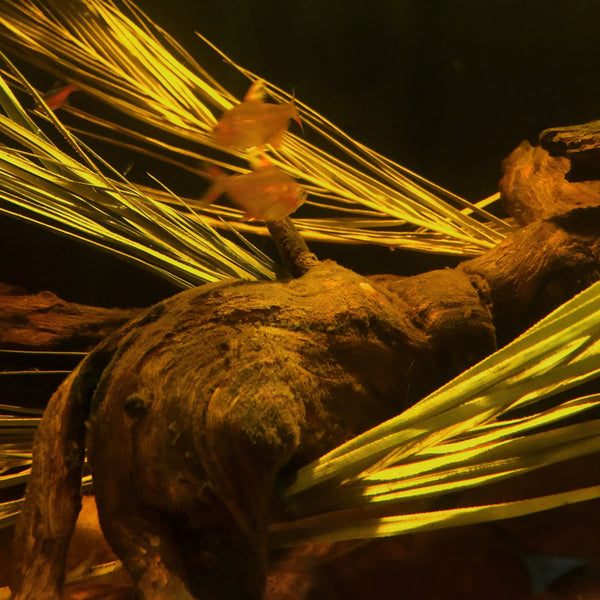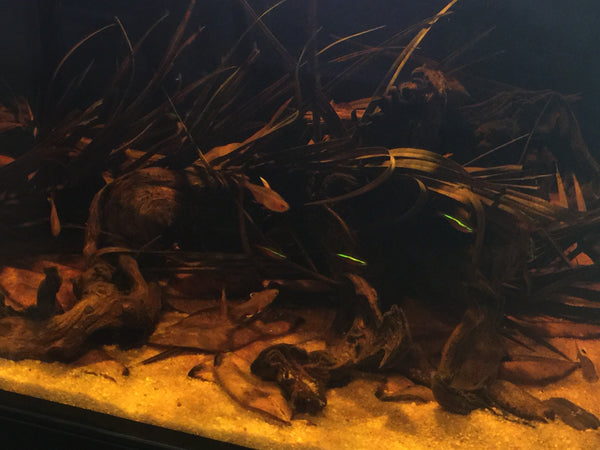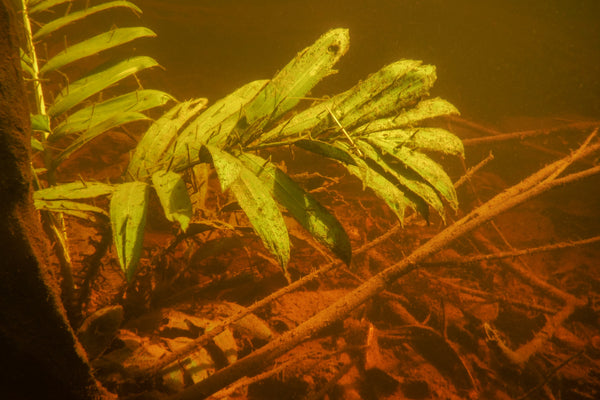By now, you know that my mind works sort of strangely. I always have different ideas and I’m always moving. It’s a good thing, but it can also be bad when you have limited time, space, money, etc. Yet, the desire to try all of the new ideas I have keeps me moving forward. And hopefully, inspires a few of you now and again.

Ok, so I'm in one of those modes again where I've decided to plan a new tank for my home...This is usually the totally fun part of the hobby...I mean, you have a world of possibilities, you've made the mental commitment to move forward, and you haven't spilled a drop of water or spent any money yet…
Yeah, it's pretty cool.

One thing I have decided is that this will be a marine aquarium. The allure of having a freshwater, brackish, and marine tank under one roof is just too cool for a fish geek to pass up! Besides, my “pedigree” (and reef keeping buddies) are demanding it, lol. And with a clean slate, it’s kind of ridiculously exciting. Although, I’ve given myself a “dangerously comfortable” starting date of “2018” (like, that gives me 364 days before I even have to start!)… Now, I don’t want to blow it. I’ve seen too many hobbyists decide to set up a tank- or more than one- with great fanfare- only to have them be just new versions of the same old thing that they and every other hobbyist has played with for the past decade.. Yawn. Blown opportunity. I mean, where’s the fun in that? How does this push the hobby forward? Okay, I suppose it can be fun- and who am I to ridicule? But still, it’s a blessing to be able to set up another tank, and I want to create something kind of different.
And of course, nothing I ever do is “conventional”, concept wise…

So, I'm in a bit of a conundrum. I mean, I have a bunch of ideas that have been percolating in my head for...well- years! I told myself that "...My NEXT tank is gonna be the one where I finally do_________."
All of these ideas...And I still have that same feeling of-what would it be…restriction? Frustration? Not sure what it is- when you just have to have one tank to make it happen...Ridiculous that I should feel this way- I'm fortunate to be able to build even one tank. Of course, in my head, I have unlimited ideas...many of which never really get out of the theoretical phase. I used to laugh at news reports when NASA announced that it committed $4,000,000 to the study of building a starship, or some other thing for which the actual capability doesn't even exist yet- and likely won't for decades, if not longer. I mean, why? And yet, I kind of understand now...It's like, I am appropriating all of this "mental funding" to study some of my concept tanks that I really don't have the means to pull off.

Well, that's kind of fun, actually! What hobbyist doesn't look at their tank and think (or even say!), "Next, I'm gonna build a tank that has___________."

I think that's what keeps us moving forward, right?
So anyways, I've narrowed down my range to a few concepts- each one quite different from the other. Although the exercise works with freshwater, too, this is about saltwater today, and might bore the shit out of you. Some of you who are 110%, dyed-in-the-wool freshwater fanatics will probably stop reading at this point, questioning why I’d even consider this…I totally understand. Not your thing. Can’t blame you. Catch you tomorrow.

Yet, I continue…going back and forth, getting mentally committed to one idea, and then seeing pics or videos a habitat I like, or talking to a fellow hobbyist, and then getting turned around into one of the other ideas I've been playing with...Wow. Crazy. The goal is not to get into an endless loop of "analysis paralysis" and never make a move simply because I'm "still planning..." Yeah. I've seen guys do that, and the new tank literally sits and collects cobwebs for years while they are "contemplating." Yuck.

I've learned that, in this internet-enabled age, it's sometimes cool to throw your ideas out to your friends in “cyberworld” for their two cents worth...So, why not, right?
So here are some of the finalists in my "2018 concept" reef study...I'm curious about your take on them:

Goniopora "lagoon", with Goniopora, Catalaphyllia, and some Fungiids, on a non-conventional rich, deep substrate with seagrasses and macro algae. These are really interesting corals, which are often found in the sand in lagoons…So, this means minimal rock work. Maybe even a few gorgonians. Kind of unconventional. Really, a sort of “botanical-style” marine tank, with a completely different vibe than the “clinically clean” ones, filled with “fuzzy sticks” (“SPS” corals) which come to everyone’s mind when they see the words “reef tank.” Fishes would be interesting- mostly Blennies, gobies, and a few Pipefish. Perhaps I might throw in a captive-bred Filefish…

A small "patch reef" simulation...Like the kind I saw a lot in Fiji and French Polynesia: Little "islands" of rock in an otherwise sandy “wasteland”, covered in Acropora colonies. Lots of tiny gobies, and maybe some Damselfish for good measure. Really bright light. Simple and familiar in some respects, but a bit unconventional form a ‘scaping perspective, by means of its large amount of negative space…Yet, I think I’m ready to squelch this one…Yawn.

A near-monospecific soft coral reef, with only really “choice” specimens of either Sarcophyton (like the killer Yellow or Neon Green ones), Sinularia, or perhaps a few Capnella...Or, the variation would be a simply old-school 1990's soft coral-dominated reef tank, with all sorts of softies in an “allopathic soup” of terpenines and other chemicals to fight for turf...perhaps with some macroalage thrown in for good measure. ON the other hand, this usually ends up being a tank packed with lots of wavy, bright coral that you need to trim constantly and give away to anyone who wants it. It will make me popular at frag swaps, perhaps…but may not really push me into new ground. Then again, when was the last time anyone set up a dedicated soft coral tank that was designed specifically with them in mind? Maybe I can just keep some of the less-represented, rare soft corals that are found in the hobby. That could be helpful…Hmmm.
A "deepwater" Acropora tank, with a maximum about 7-8 different varieties selected for appearance and interest….Targeted LED spotlighting…lot’s of blue..The fishes would be Leopard Wrasses, Halichoeres Wrasses, some Assessors, and perhaps a Genicanthus Angelfish. The obligatory gobies and blennies would be there, too, along with a “Marine Betta"...Rockwork would be highly "justified" to one side of the tank, with a lot of open sand on the other side. Maybe a smattering of rubble here and there…restraint. Hmm…still not sure I like this one..

A super-diverse, ultra biologically-rich microcosm, reminiscent of the ones I've seen in Julian Sprung's office and home aquariums. Just a combination of everything that I like, interspersed with lots of macro algae, seagrasses, gorgonians, and even a mangrove or two sticking out of the top. Brimming with life in a variety of forms. Extra credit- “evolving” my brackish water “Estuary” tank (which has yet to make its “media debut” (stay tuned) towards a full-strength saltwater tank… Ideas begat ideas…

My little Palau "coral island" palladium concept that I've been toying with forever: A centered island of rock, projecting out of the water (tank would be about half filled). In the exposed rock work, I'd create a hidden planter box for terrestrial ferns and other tropical houseplants, to create a sort of jungle. Below, would be a mixed collection of Acropora, Seriatopora, Faviids, and perhaps even a Capnella or two. A lot of brightly-colored corals in contrast with the cool green of the terrestrial plants. I'd populate the tank with lots of really colorful Halichoeres Wrasses (probably Canary Wrasses), Damsels, gobies, and maybe a Centropyge Angelfish.

A Royal Gramma-inspired Caribbean biotope simulation, with a large cave and like 20 Royal Gramma. Lots of gorgonians, and macro algae like Dictoyota (I'm serious), Padina, and some killer corallines. A collection of corals that most reefers would freak out about ("ALGAE?!?! Arrghhh!") Maybe an Indigo Hamlet and a Blackcap Basslett or two thrown in for good measure- but the Royal Gramma clan would be the stars of the show. I dove in a habitat like this in Belize a few years back and it never left my mind...
Okay, that's just a few of the "finalists" in my never-ending "elimination round" of concepts. You see, like many of you, my imagination, appetite, and enthusiasm are often larger than my ability to get the job done. I've concluded that to do all of my crazy concept tanks, I'd probably need like 17 aquariums of all shapes and sizes, many with technologies and components that would carry a breathtaking price tag...sigh.

And, this is AFTER I've eliminated some of the early front runners, like the Seahorse and Pipefish tank, the monospecific Pocillopora tank, the “Zero Diversity" concept tank, tropical tidepool, and others that are earmarked for some “indefinite” future date….

And of course, that’s just my reef tank. I’m already deep in the work on evolving my office blackwater tank, and…Yeah, never ends. Gotta keep inspiring our community with new looks and ideas.

I'm curious about what your "next" tank is going to be (fresh, salt..whatever), how you arrived at the concept, and if you actually have gotten out of the planning phase..

One of the best parts of my business is getting to help fuel the dreams of other hobbyists. It gives me great pleasure to see you guys enjoying the holy, and motivates me to do more...And of course, when it comes time to do my own tank, I have to weed through all of these crazy ideas...

On second thought, maybe I'll just do a straight-up freshwater tank! Hmm, a planted tank, with only Crypts? Botanical style, or a "jungle" concept? Hardscape? Or an African river Biotope? Would it have Nannochromis, or maybe Mormyrids and Tetras? Or maybe an Asiatic Stream tank with lots of loaches..Oh, and Sundanio, or just Danios…Maybe tons of Boraras…Or perhaps...

Arghh...I love this hobby!
I'm glad you do, too.
Until next time...Keep dreaming. Keep scheming.
Stay creative. Stay Ambitious. Stay unique. Stay focused.
And Stay Wet.
Scott Fellman
Tannin Aquatics



































































































